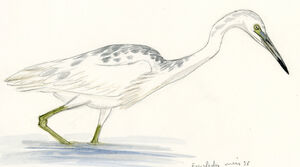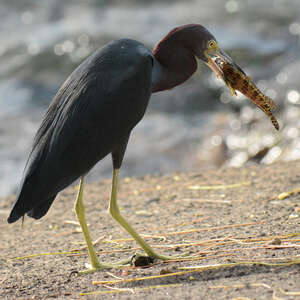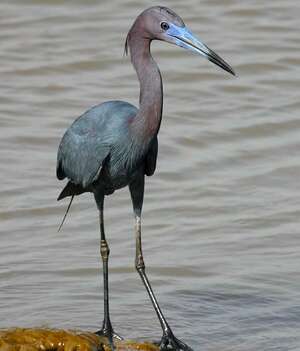Little Blue Heron
Egretta caerulea - Aigrette bleue
Identification
This relatively small species does not exhibit sexual dimorphism. The Little Blue Heron has a head and neck of brown-violet color. The rest of the body is uniformly dark gray-blue. The moderately curved downwards and pointed bill has a wide base. It is grayish with a darker tip. A gray-green area of skin can be seen at the base of the bill and in front of the eye. The latter, of yellow color, is surrounded by a small yellow-green bare skin area. Its long neck has a S-shaped form whether at rest or in flight. The legs are long and greenish. In nuptial plumage, the head and neck colors are brighter. Immatures are entirely white with gray tips of the primary remiges and pale greenish legs. They start to get blue nuances during their first molt at the age of 4 months. They will obtain the definitive, dark color of adults at the age of 2 years.
Subspecific information monotypic species
Foreign names
- Aigrette bleue,
- Garceta azul,
- garça-morena,
- Blaureiher,
- kék gém,
- Kleine Blauwe Reiger,
- Airone azzurro minore,
- blåhäger,
- Blåhegre,
- volavka modrosivá,
- volavka modrošedá,
- Blåhejre,
- sinihaikara,
- Kleinbloureier,
- martinet blavós,
- Mýrahegri,
- czapla śniada,
- zilais gārnis,
- modra čaplja,
- Малая голубая цапля,
- ヒメアカクロサギ,
- 小蓝鹭,
- blåhäger,
- 小藍鷺,
Voice song and call
Habitat
The Little Blue Heron mainly frequents shallow inland wetlands: marshes, ponds, lakes, flooded meadows and rice paddies. However, it can also be found in brackish or salty habitats such as mangroves and sheltered coastal tidal flats. In the Andes it can go as high as 3000 m above sea level.
Behaviour character trait
North American subjects migrate south in winter. The Little Blue Heron is solitary, but it nests in small or large colonies, along with other herons. It is mostly active during the day. It seeks out aquatic animals by slowly walking across shallow bodies of water. It scrapes the bottom with its fingers to dislodge its prey which it then pierces with its beak before swallowing it head first.
Flight
Dietfeeding habits
Reproduction nesting
During the nuptial parade, the male assumes a crouching position with his neck and beak pointed to the sky.
The bird swings its neck, claps its beak, and emits vocalizations. The seduced female approaches him. After a somewhat rough first approach they come to mutual grooming and entwined necks. The male then presents twigs to the female while puffing up his feathers. The female takes the twigs and arranges them to shape the nest. This last one, of small size and rudimentary, is built between 3 and 12 m of height. The female will lay between 3 and 5 eggs, of blue-green color, in April. She lays an egg per day and the incubation, assured by the two parents, will last about 21 days. The parents feed chicks by dropping food in the nest, and later, by directly putting it in their beak. The chicks leave the nest after three weeks making small forays around. At the age of 30 days they can fly and risk being away from the nest. They are independent at two months and reach their sexual maturity at the age of one year.Geographic range
Threats - protection
IUCN conservation status
concern
in the Wild
threatened
evaluated
The Little Blue Heron is seeing its habitat areas decrease due to wetland drainage and forestry cuts. Its populations are decreasing and this species is considered to be threatened.
Sources of information
- IOC World Bird List (v15.1), Gill, F and D Donsker (Eds). 2025-12-07.
- Vol. 1 - Handbook of the Birds of the World, Josep del Hoyo-Andrew Elliot-Jordi Sargatal
Other sources of interest
 Specification sheet created on
03/08/2023 by Jean-Pierre Trouillas
Specification sheet created on
03/08/2023 by Jean-Pierre TrouillasTranslation by AI Oiseaux.net
© 1996-2026 Oiseaux.net
- Accipitriformes
- Aegotheliformes
- Anseriformes
- Apodiformes
- Apterygiformes
- Bucerotiformes
- Caprimulgiformes
- Cariamiformes
- Casuariiformes
- Charadriiformes
- Ciconiiformes
- Coliiformes
- Columbiformes
- Coraciiformes
- Cuculiformes
- Eurypygiformes
- Falconiformes
- Galliformes
- Gaviiformes
- Gruiformes
- Leptosomiformes
- Mesitornithiformes
- Musophagiformes
- Nyctibiiformes
- Opisthocomiformes
- Otidiformes
- Passeriformes
- Pelecaniformes
- Phaethontiformes
- Phoenicopteriformes
- Piciformes
- Podargiformes
- Podicipediformes
- Procellariiformes
- Psittaciformes
- Pterocliformes
- Rheiformes
- Sphenisciformes
- Steatornithiformes
- Strigiformes
- Struthioniformes
- Suliformes
- Tinamiformes
- Trogoniformes
































